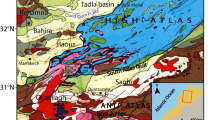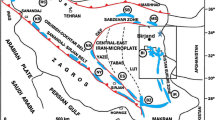Abstract
Reconstruction of structural controls on hydrothermal deposits is fundamental to predictive models of different ore deposits. Since fractal/multifractal modeling is an effective instrument for separation of geological and mineralized zones from background, therefore concentration-distance to magnetic basement lineament (C-DMBL) fractal model and distribution of Au anomalies were used to classify Au mineralizations according to their distance to magnetic basement lineament. Application of the C-DMBL model for the classification of Au mineralization in the Takab 1:100,000 sheets based on streams sediment data, reveals that the main gold mineralizations have a strong correlation with their distance to magnetic basement lineament in the area. The distances of gold extreme anomalies having Au values higher than 692 ppb to magnetic basement lineament are less than 2 km showing a positive correlation between Au anomalies and tectonic events. Moreover, gold mines have average distances to magnetic basement lineament less than 6 km and validate the results derived via the C-DMBL fractal model. The C-DMBL fractal modeling can be utilized for the reconnaissance and prospecting of magmatic and hydrothermal deposits.
Similar content being viewed by others
Avoid common mistakes on your manuscript.
Introduction
It has determined that the formation of hydrothermal mineral deposits is often the result of interaction between several key processes including structures, fluid flow, and geothermal transport as well as geochemical processes (Zhang et al. 2011). The separation of geochemical anomalies from background is an important procedure in mineral exploration. However, recognition and delineation of the anomalies with the aim of predicting the occurrence of mineral deposits need prior knowledge of geo-anomaly according to mineralization types, grade distributions, and geneses as well as knowledge of advanced methods for their quantitative mapping.
The separation of anomalies from background is the most significant aim of geochemical exploration operations particularly for metallic ore deposits. Several methods are used for fractal and multifractal modeling and singularity modeling (Wang et al. 2012). The fractal theory has been established by Mandelbrot (1983) as an important non-Euclidean branch in geometry.
The aim of structural analysis applied to mineralization is to recognize what deformation influenced the increase or decrease of permeability in rocks, both spatially and over time. There is a positive correlation between tectonic and hydrothermal mineralization. The aim of this study is to classify Au mineralization according to their distance from magnetic basement lineament by concentration-distance to magnetic basement lineament (C-DMBL) fractal model and distribution of Au anomalies by using a multifractal method, in Takab area, NW Iran.
Geological setting of the Takab area
The Takab area is mountainous and semi-arid which lies at the boundary of the Urmieh–Dokhtar magmatic arc and the Sanandaj–Sirjan overthrust belts, both of which extend more than 2000 km in a NW-SE direction parallel to the Zagros thrust fault. Tertiary volcano-plutonic rocks of the Urmieh–Dokhtar mostly comprise Precambrian metamorphic, Tertiary volcanics (with subordinate granitoids and sediments) and Quaternary sediments (Fig. 1).
Urmieh-Dokhtar magmatic arc
Dominant structural trend in Urmieh–Dokhtar province (Fig. 1) is NW-SE. From tectonics view, it contains a magmatic arc that is the result of subduction beneath southern active continental margin of Cimmerian plate. Also, it is marked by widespread Eocene volcanism.
Sanandaj–Sirjan overthrust belts
Dominant structural trend in Sanandaj–Sirjan province (Fig. 1) is NW-SE. From tectonics view, it contains Sanandaj–Sirjan overthrust belts which is formed by metamorphic rocks of the northeastern part of Arabian plate. Late Cretaceous-Paleogene sequences in this belt have piled up on a wedge top part of Zagros proforeland basin, before regional metamorphism. Pre-Cretaceous metamorphic rocks have exposed in this province by upthrusting of basement wedges. Taken from aeromagnetic map of Shahindezh (Yousefi and Friedberg 1978) are some major faults and magnetic lineaments with 2–6 km depth whose depth increases toward the south west. These are illustrated in Fig. 2.
Materials and methods
Number-size fractal method
Geological differences can be shown in logarithmic plots of fractal methods. The breaks among straight-line segments on the plots and the corresponding values of elemental concentration have been used as thresholds to decompose geochemical values into dissimilar components, representing different causal factors, such as lithological differences and geochemical processes (Carranza 2010). Multifractal theory can be interpreted as a theoretical structure that explains the power-law relationships between number of concentrations below a given value and the actual concentrations itself. To reveal and prove that data distribution has a multifractal nature, a rather extensive computation is required.
The number-size (N-S) method was originally proposed by Mandelbrot (1983) and can be used to describe the distribution of geochemical populations without pre-processing the data. Based on this model, Agterberg (1995) proposed a multifractal model in order to determine the spatial distributions of giant and super-giant ore deposits.
Concentration-distance to magnetic basement lineament fractal model
The C-DMBL fractal model is an extension of the N-S model in the study. The model has the following form:
Where ρ shows element concentration, DMBL (≥ρ) indicates cumulative distance from magnetic basement lineament of sampled sites with concentration values greater than or equal to ρ, F is a constant, and D is the scaling exponent or fractal dimension of the distribution of element concentrations. Based on this model, metallic mines, deposits, and occurrences were classified according to their distance from magnetic basement lineament.
Result and discussion
Application of N-S fractal method in stream sediment
The analyzed samples were sorted in decreasing order of grades from which cumulative numbers were calculated. Finally, the log–log plot was generated for Au (Fig. 3). Breaking points between straight-line segments in the log–log plot represent threshold values separating sets of samples whose geochemical concentration values outline distinct geological and geochemical processes. The log–log graph of the N-S model can be fitted with four straight-line segments, indicating the presence of four populations that can be separated by threshold values at the breaks in slopes of the straight-line segments. These four populations, from lowest to highest values, are considered to represent background, moderate, high and extreme anomalies.
The area was gridded with cells of 180 × 180 m2 for the interpolation of Au values. The interpolation method used is the inverse squared distance (ISD) which was used for the generation of maps of Au concentration. This procedure is preferred because it reduces the undesirable smoothing effects caused by Kriging. Kriging also contains inherently high truncation errors for the upper and lower boundaries of ore grades. The high values of Au (≥50 ppb) are located in the central, NE, and western parts of the Takab area, as depicted in Fig. 3.
Application of concentration-distance to magnetic basement lineament fractal model
Based on C-DMBL fractal modeling, five geochemical groups were separated based on the existence of known Au extreme anomalies in the Takab area, as shown in Table 1. The log–log plot illustrates that there are two major phases for Au mineralization which have a multifractal character (Fig. 4). Gold extreme anomalies with enrichment mineralization have Au values higher than 417 ppb. The anomalies are located at distances less than 3 km from magnetic basement lineament (Table 1). The results indicate that there is a relation between increase in grades of gold anomalies and decrease in the distance between the magnetic basement lineament and the gold extreme anomalies in the area.
Also, the gold mines were used to validate the C-DMBL model’s results. All gold mines have an average distance less than 6 km to the magnetic basement lineament.
Conclusions
Application of the concentration-distance to magnetic basement lineament (C-DMBL) fractal model in the Takab area reveals that the main gold mineralization are strongly correlated with their distance from the magnetic basement lineament in the study area. The distances between known gold mineralization with Au values higher than 417 ppb to magnetic basement lineament are less than 3 km which shows a positive correlation between Au mineralization and the main faults.
Moreover, magnetic basement lineament has played the main roles in hydrothermal fluids flow and the gold mineralization in the area. Based on the results, the C-DMBL fractal modeling can be utilized for the reconnaissance and prospecting of magmatic and hydrothermal deposits.
References
Agterberg FP (1995) Multifractal modeling of the sizes and grades of giant and supergiant deposits. Int Geol Rev 37:1–8
Arian M (2011) Basement tectonics and geology of Iran. Asar Nafis Press, Tehran
Carranza EJM (2010) Catchment basin modelling of stream sediment anomalies revisited: incorporation of EDA and fractal analysis. In: geochemistry: exploration, environment, analysis. Geochem Explor Environ Anal 10:365–381
Fonoudi M (1999) Geological map of Takab, Geol Surv. Iran, Tehran
Mandelbrot BB (1983) The fractal geometry of nature. Freeman, San Fransisco, pp 1–468
Wang W, Zhao J, Cheng Q, Liu J (2012) Tectonic–geochemical exploration modeling for characterizing geo-anomalies in southeastern Yunnan district, China. J Geochem Explor 122:71–80
Yousefi E, Friedberg JL (1978) Aeromagnetic map of Shahin Dezh. Geol Surv Iran, Tehran
Zhang Y, Robinson J, Schaubs PM (2011) Numerical modelling of structural controls on fluid flow and mineralization. Geosci Front 2:449–461
Author information
Authors and Affiliations
Corresponding author
Rights and permissions
About this article
Cite this article
Nouri, R., Arian, M. Multifractal modeling of the gold mineralization in the Takab area (NW Iran). Arab J Geosci 10, 105 (2017). https://doi.org/10.1007/s12517-017-2923-2
Received:
Accepted:
Published:
DOI: https://doi.org/10.1007/s12517-017-2923-2








